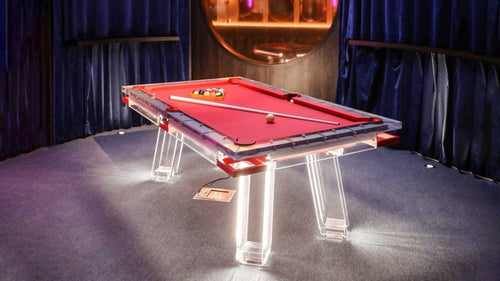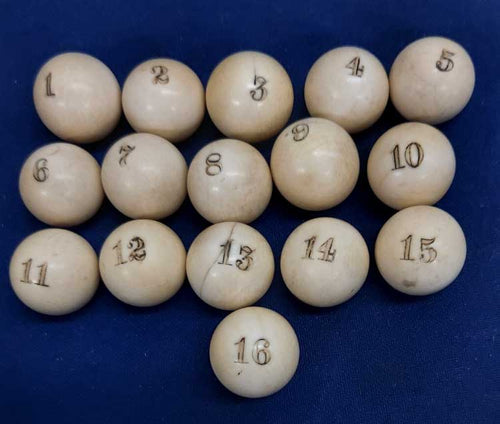Enjoy our modern designs
Straight Pool, also known as 14.1 Continuous or Rack Pool, has long been a staple of the billiards world. It is a game rich in history, demanding skill, strategy, and precision. This guide provides an in-depth look at its history, rules, strategies, and tips to help you improve your game.
I. History and Overview
Straight Pool emerged from earlier billiard games that were played outdoors. By the late 1800s, indoor pool games with pocketed tables began to diverge from carom and snooker due to the growing popularity of games that required precision pocketing skills. During early American championships, a version called 61 Pool was popular, where points were awarded based on the number assigned to each ball.
In 1910, Jerome Keogh revolutionized pool by introducing the concept of 14.1 continuous. In this game, after pocketing 14 balls, players re-rack them and continue by breaking the new rack with the 15th ball. This concept laid the groundwork for modern Straight Pool.
Straight Pool was the dominant professional billiard game for nearly a century, eventually giving way to Nine-Ball in the late 1970s and early 1980s due to its faster pace and greater appeal to television audiences.
Key Historical Figures

- Willie Mosconi: Often regarded as one of the greatest pool players of all time, Willie Mosconi dominated the Straight Pool scene for decades. His precision and strategic prowess earned him numerous world titles, and he played a significant role in popularizing the game. Mosconi's legacy includes the establishment of the Mosconi Cup, an annual nine-ball tournament between Europe and the USA, further cementing his impact on the sport.
- Edwin "Ed" Kelly: Another pivotal figure in Straight Pool history, Ed Kelly was a dominant force in the late 19th and early 20th centuries. His competitive spirit and numerous championships helped elevate the status of Straight Pool in professional billiards.
- Efren Reyes: Although more renowned for his expertise in other pool disciplines, Efren "Bata" Reyes has also made significant contributions to Straight Pool, showcasing the game's enduring appeal across different styles and generations.
II. Rules and Gameplay
Straight Pool is played between two players or teams, with the goal of reaching a predetermined score (typically 100 or 150 points). Each legally pocketed ball earns one point.
Key Rules
- Call Shot: Players must announce which ball and pocket they intend to hit.
- Legal Shot: The cue ball must strike an object ball, and either a ball must be pocketed or an object ball must contact a rail.
- Fouls: Standard fouls, like pocketing the cue ball or knocking a ball off the table, result in a one-point deduction.
- Breaking Fouls: Fouls on the break shot deduct two points.
- Three-Foul Rule: Committing three consecutive fouls results in a 15-point penalty. This penalty is enforced after a formal warning following the second consecutive foul. It's crucial to maintain composure and avoid repeated mistakes to prevent this significant point deduction.
- Spotting: Balls pocketed illegally or knocked off the table are placed on the apex spot.
- Racking: After 14 balls are pocketed, they are re-racked, excluding the apex ball.
Specific Rules for Breaking
- Opening Break: The player must either pocket a called ball or execute a legal safety. For a safety, the cue ball must strike the rack and a rail, with at least two object balls also hitting a rail.
- Regular Break: After each rack of 14, the player pockets the last ball and then uses it to break open the next rack.
Modern Tournament Formats and Variations

While traditional Straight Pool remains popular, several modern adaptations and tournament formats have emerged to keep the game dynamic and appealing:
- World Straight Pool Championship: This prestigious tournament has a storied history but has been less active in recent decades. Efforts to revive it continue, aiming to showcase the highest level of competition in Straight Pool.
- Team Events: While the Mosconi Cup is specifically a nine-ball tournament between Europe and the USA, there are occasional team-based events and exhibitions in Straight Pool that add a collaborative element to the game, fostering national and regional rivalries.
- Timed Matches: Introducing time constraints for each shot or inning adds pressure and tests players' ability to perform under stress. This variation is used in some local and exhibition matches to increase excitement.
- Hybrid Formats: Combining elements from different pool games, such as integrating aspects of Nine-Ball into Straight Pool, creates unique challenges and broadens the game's appeal. These hybrid formats are often used in exhibition matches or special tournaments to attract a wider audience.
(Corrections and clarifications made regarding the Mosconi Cup and the status of the World Straight Pool Championship.)
III. Strategies and Techniques
A. Break Shots
Opening Break Safety
Hit a corner ball thinly to send the cue ball diagonally across the table, ensuring two balls make contact with rails while leaving limited options for your opponent.
Regular Break Shots
Select the "break ball" carefully to create a favorable angle for breaking open the new rack. For example, choosing a ball positioned near a side pocket often provides a good angle to spread the next rack effectively, as it allows for better control of both the cue ball and object balls, ensuring a more even distribution across the table.
Types of Break Shots
- Side of Rack Breaks (most common)
- Middle of Rack Breaks (ideal for clean spreads)
- Below Rack Breaks
- Side Pocket Breaks
- Rail Breaks
- Inside/Outside Angle Break Shots: Use topspin or draw to control the cue ball's path effectively.
B. Pattern Play and Cluster Management
Progressing the Rack
Aim to improve the table layout with each shot, breaking clusters and increasing scoring opportunities.
Insurance Balls
Identify balls close to pockets that can act as fallback shots after attempting cluster breakouts.
End Patterns
Plan your final few shots to position the cue ball for the next break shot.
Key Ball (K1) and K2 Ball
Identify the key balls needed to transition to the break ball smoothly. For example, the K1 ball should ideally be positioned to easily lead into the break ball, while the K2 ball should help set up the K1 ball with minimal cue ball movement.
The Triangle Concept
Identify three-ball clusters that allow minimal cue ball movement for better control. For example, look for three balls that are positioned close together in a way that allows you to pocket each one with minimal repositioning of the cue ball, ideally creating a natural flow from one shot to the next.
C. Safety Play
- Skim Safeties: Feather an object ball to leave your opponent with a tough shot.
- Stick Safeties: Leave the cue ball frozen against an object ball, complicating your opponent's options.
- Distance Safeties: Send the cue ball far from object balls, making it harder for your opponent to execute an easy shot.
- Intentional Fouls: Occasionally sacrificing a point is worth preventing your opponent from gaining an advantage, especially under the three-foul rule.
IV. Tips for Improvement
Practice Drills
- L Drill: Develops cue ball control by focusing on precise positioning.
- Circle Drill: Sharpens accuracy in a confined area.
- Side Pocket Semicircle Drill: Refines draw shots and cue ball manipulation.
Practice Routines
- Clear the Table: Practice clearing randomly distributed balls to enhance consistency.
- Call Next Shot: Enforce strategic planning by always thinking ahead.
- Equal Offense: Simulates Straight Pool gameplay, focusing on break shots and scoring efficiency.
Track Performance
- Balls Per Inning (BPI): Track your average BPI to monitor progress.
- High Run Scores: Set personal high run goals and try to beat them.
- Study Professional Matches: Study top players' strategies, cue ball control techniques, and shot selection to improve your own game.
V. Conclusion
Straight Pool is a game of precision, strategy, and mental endurance. Mastering it requires diligent practice and thoughtful planning. It also demands a deep understanding of the game's subtleties. Remember to enjoy the learning process, celebrate small improvements, and stay motivated—progress in Straight Pool is as much about the journey as it is about reaching mastery.
With continuous practice, strategic planning, and relentless self-improvement, you can develop the skills needed to excel at this rewarding game. Every shot is an opportunity to improve the layout, position yourself for success, and add to your high run.
VI. Modern Adaptations and Future of Straight Pool
As the billiards community continues to evolve, Straight Pool adapts to modern trends and technological advancements:
- Digital Training Tools: Apps and software that analyze shot patterns and provide feedback help players refine their techniques more efficiently.
- Hybrid Tournaments: Events that blend Straight Pool with other cue sports attract a broader audience and encourage players to develop versatile skill sets.
- Global Expansion: Increased international interest has led to more diverse competition fields, enriching the game's cultural tapestry.
Straight Pool remains a beloved and challenging discipline within the billiards world, balancing tradition with innovation. Whether you're a novice looking to learn or a seasoned player aiming to perfect your game, Straight Pool offers endless opportunities for growth and enjoyment.


















